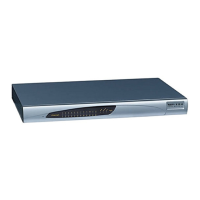The FXS port behaves according to the settings of the
FXSOOSBehavior parameter such as playing a reorder tone when the
phone is off-hooked, or changing the line polarity.
These behaviors are done upon one of the following scenarios:
The device is physically disconnected from the network (i.e.,
Ethernet cable is disconnected).
The Ethernet cable is connected, but the device is unable to
communicate with any host. For this scenario, the LAN Watch-Dog
must be activated (i.e., set the EnableLANWatchDog parameter to
1).
The device can't communicate with the proxy (according to the Proxy
Keep-Alive mechanism) and no other alternative route exists to send
the call.
The IP Connectivity mechanism is enabled (using the
AltRoutingTel2IPEnable parameter) and there is no connectivity to
any destination IP address.
Notes:
The FXSOOSBehavior parameter determines the behavior of the
FXS endpoints when a Busy Out or Graceful Lock occurs.
FXO endpoints during Busy Out and Lock are inactive.
See the LifeLineType parameter for complementary optional
behavior.
Web: Out-Of-Service
Behavior
EMS:FXS OOS Behavior
[FXSOOSBehavior]
Determines the behavior of FXS endpoints when a Busy Out condition
exists.
[0] None = Silence is heard when the FXS endpoint goes off-hook.
[1] Reorder Tone = (Default) The device plays a reorder tone to the
connected phone / PBX.
[2] Polarity Reversal = The device reverses the polarity of the
endpoint making it unusable (relevant, for example, for PBX DID
lines).
[3] Reorder Tone + Polarity Reversal = Same as options [1] and [2].
[4] Current Disconnect = The device disconnects the current to the
FXS endpoint.
Notes:
A device reset is required for this parameter to take effect when it is
set to [2], [3], or [4].
This parameter is applicable only to FXS interfaces.
Retransmission Parameters
Web: SIP T1
Retransmission Timer
[msec]
EMS: T1 RTX
[SipT1Rtx]
Defines the time interval (in msec) between the first transmission of a
SIP message and the first retransmission of the same message.
The default is 500.
Note: The time interval between subsequent retransmissions of the
same SIP message starts with SipT1Rtx. For INVITE requests, it is
multiplied by two for each new retransmitted message. For all other SIP
messages, it is multiplied by two until SipT2Rtx. For example, assuming
SipT1Rtx = 500 and SipT2Rtx = 4000:
The first retransmission is sent after 500 msec.
The second retransmission is sent after 1000 (2*500) msec.
The third retransmission is sent after 2000 (2*1000) msec.
